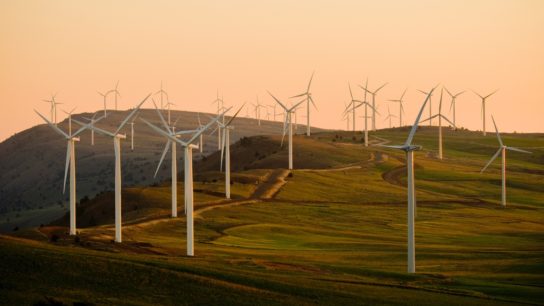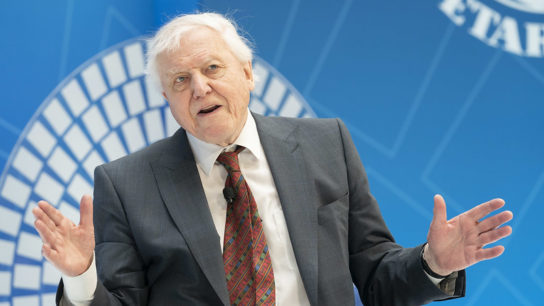Democrat-led state commitments to climate action provide a glimmer of hope in a second Trump Administration. Voters in Washington State rejected a ballot initiative to repeal the state cap-and-invest program modeled after the program in California. Meanwhile, New York is in the process of developing their own cap-and-invest program. These state actions will be critical for countering a comprehensive rollback of national climate policy, emission regulations, environmental protections in favor of accelerated fossil fuel development expected in a second Trump term.
—
Washington State preserved its cap-and-invest program that was established in 2021 through passage of the Climate Commitment Act as a primary strategy for achieving the state’s emission reduction goals of 45% below 1990 levels by 2030 and 95% below 1990 levels by 2050.
This market-based system requires emitters, including utilities, fuel suppliers, waste-to-energy facilities and others, to purchase credits equal to their greenhouse gas emissions in quarterly auctions. The number of credits available is reduced over time to incentivize carbon emission reduction and ensure that the state reaches its targets.
Held in 2023, the first Climate Commitment Act auction generated $3.2 billion in revenue, supporting over 100 climate mitigation and adaptation projects. These included free public transit for youth under 18, conversion of ferries to hybrid-electric, electric vehicle charging infrastructure, building decarbonization, large-scale solar installations, energy vouchers for low-income customers, support for diverse adaptation projects across Tribal resilience, riparian protection and wildfire restoration and prevention. A report by the Washington State Department of Ecology estimated the total emission reduction across all funded programs equivalent to 45,000 cars driven for one year.
The future of the Climate Commitment Act was threatened by ballot Initiative 2117. This would have repealed the law, cap-and-invest system and prohibited the Washington State Legislature from ever implementing another carbon credit program. Initiative 2117 was funded by one wealthy hedge fund manager who blamed the cap-and-invest program for imposing additional costs on fossil fuel suppliers that contributed to high gas prices relative to other states.
A coalition of nearly 600 members including unions, community groups, farmers, doctors, firefighters, faith leaders, healthcare organizations, businesses and tribes aided by hundreds of volunteers launched an aggressive state-wide campaign urging voters to “vote no” on Initiative 2117, highlighting the diverse programs funded and benefits already provided by the Climate Commitment Act to state residents and impact on programs, services and prospects for climate action if passed. This effort was successful as polling conducted in early spring 2024 indicated support for the measure and months of voter outreach and messaging resulted in a clear rejection of Initiative 2117 with 62% rejecting the initiative.
Support for the Climate Commitment Act was broadly distributed across progressive urban counties such as King that includes the City of Seattle and deeply conservative rural counties in central and eastern Washington. Outgoing Washington State Governor Jay Inslee, who has been a fierce champion of climate action through three four-year terms, celebrated the vote: “Washingtonians said loud and clear that they value clean air and clean water – and they don’t want to go backwards. This is a victory for clean air, clean energy jobs and a stronger economy in the Evergreen State,” Inslee said.
Momentum for Climate Policy in Other Blue States
A successful effort to repeal the Climate Commitment Act in Washington State may have inspired similar ballot initiatives in other states that have implemented cap-and-invest or other major policies to address climate change.
This includes California, the first state to implement an economy-wide cap-and-invest program – the Regional Greenhouse Gas Initiative (RGGI) – a cooperative effort of 11 Eastern states to cap and reduce power sector carbon dioxide emissions; New York, which is both a member of the Regional Greenhouse Gas Initiative and currently developing an economy-wide cap-and-invest program; and Oregon, which is re-establishing a narrower program resembling cap-and-trade but does include carbon allowance trading via auction.
California – Pioneer for State Climate Action
The “golden” state is home to nearly 39 million people who contribute to the fifth-largest economy in the world. California is second to Texas in total greenhouse gas emissions generated per year. However, on a per capita basis, California ranks as third-lowest in the US in terms of metric tons per person. This is due in part to the state’s ambitious carbon reduction goals, policies and public investments in clean energy and infrastructure.

A major component of California’s emission reduction strategy is its Cap-and-Trade Program, implemented in 2013. The program covers 80% of total state greenhouse gas emissions, with a cap on emissions that has declined 2-3% per year since 2014. The 450 entities covered by the law, including fuel suppliers and refiners, electrical utilities, chemical producers, and industrial manufacturers, must purchase allowances to cover their emissions in state-administered auctions, with an increasing annual minimum allowance price to incentivize participants to reduce their emissions.
The Cap-and-Trade carbon allowance auctions have generated $11 billion for climate programs since 2014. These funds have supported hundreds of thousands of new projects across low carbon transportation, wildfire prevention, renewable energy, emergency preparedness, community air protection, climate adaptation and other priority areas. Equity and environmental justice are prioritized as by law, a minimum of 35% of auction proceeds must directly benefit disadvantaged and low-income communities and households at greater risk to be impacted by climate change. To-date, 76% of program funding has been allocated to projects benefiting these priority populations.
Over 10 years projects funded by the California Cap-and-Trade program have achieved impressive benefits for the economy, public health, environment as well as climate mitigation and adaptation efforts. The program is estimated to have reduced greenhouse gas emissions by a total of 109.2 million metric tons of carbon dioxide equivalents and reduced year-on-year emissions from most sectors with over 105,000 less tons of pollutants in the air. Improved air quality is credited with a range of public health benefits, including over 1,000 avoided premature deaths, hundreds of avoided hospitalizations and ER visits for respiratory illness and asthma.
Cap-and-Trade funded projects have created 29,000 jobs and invested heavily in workforce development for priority populations in fields such as electric public transportation, renewable energy and environmental restoration. The program has also supported strategies to combat the cost-of-living and housing crisis in California – which has consistently ranked as one of the most expensive states – through rebates and incentives for weatherization, heating and cooling upgrades, electric vehicle subsidies and energy efficient low-income housing construction.
You might also like: Leading the Way: California’s Trailblazing Efforts to Fight Climate Change
National Climate Action Again Under Threat from Trump
Trump won by 86 electoral votes and was the first Republican to win the popular vote since George W. Bush in 2004. He will assume office with Republican majorities in both the Senate and House of Representatives, all but ensuring he will have few obstacles to rolling back federal climate commitments, policies, programs and regulations.

In his first term, Trump withdrew the US from the Paris Climate Agreement, appointed a former fossil fuel lobbyist to head the EPA, and filled staff positions and advisory committees at EPA and Interior responsible for informing policy development with former fossil fuel industry representatives.
His administration initiated the largest reduction of protected lands in US history, shrinking national monuments to allow for expanded oil and gas drilling. This included a 51% reduction to Grand Staircase-Escalante and 85% cut to Bears Ears National Monuments in Utah and a recommendation that a significant portion of the 9.37-million-acre Tongass National Forest in Alaska be opened for logging.
The Trump Administration also proposed broad revisions to the Endangered Species Act to reduce protections for species classified as “threatened” and allow for consideration of economic factors (i.e. potential for fossil fuel development in their habitat) in determining if a species is to be listed as “endangered”.
Major Obama era emission reduction policies were significantly weakened, including removing greenhouse gas emissions reduction targets from the Clean Power Plan and reducing vehicle fuel efficiency standard increases from 5% to 1.5% per year.
President-elect Trump has committed to again shifting the US away from addressing climate change in his second term. This includes a second withdrawal from the Paris Climate Agreement, slashing regulations aimed at reducing carbon emissions, approving new fossil fuel pipelines, reopening offshore drilling and the Arctic National Wildlife Refuge for oil and gas exploration, restricting or redirecting billions in funding for climate programs available through the Inflation Reduction Act. His appointments of two loyalists in former New York Representative Lee Zeldin to head the Environmental Protection Agency and North Dakota Governor Doug Burgum to lead both the Interior Department and a newly formed National Energy Council further reinforces a commitment to prioritizing deregulation and fossil fuel development.
More on the topic: Environmentalists Weigh In on Trump Cabinet Picks
Global Progress on Climate in Limbo
The anticipated withdrawal of the US from the Paris Climate Agreement will worsen already slowing global momentum. An updated projection of future warming released ahead of the COP29 Climate Change Conference indicated that due to weak emission reduction targets, inadequate implementation of climate reduction policies and all-time high fossil fuel subsidies driving increasing emissions the world has already warmed 1.3C. There is now almost no path to limit warming below the 1.5C Paris target, with warming now on track to reach up to 3.1C by 2100.

Despite an unprecedented commitment to address climate change by the Biden Administration and passage of the Inflation Reduction Act containing over $350 billion in funding for emission reduction strategies, the country is falling short of the progress necessary to meet its domestic goals and be aligned with a global path to 1.5C warming or under. The anticipated comprehensive rollback of climate policies, regulations, programs and further acceleration of fossil fuel development under a second Trump Administration may add .04 of warming by 2100, but there is a risk the impact could be far greater if other high-emitting countries follow the US and exit the Paris Climate Agreement, weaken their emission reduction targets, or increase fossil fuel development.
Pressure on Blue States to Maintain Climate Change Progress
Governors from progressive states including California, Washington, Illinois and New York are actively preparing to counter Trump Administration policies on climate change and the environment.

California and Washington State under Attorney General and newly elected Governor Bob Ferguson were especially aggressive during the first Trump Administration, each filing dozens of successful lawsuits contesting weakening of environmental regulations to favor fossil fuel extraction. California Governor Gavin Newsom called a special session of the state legislature to plan for battling Trump policies. It may include canceling the EPA waiver that allows California to establish its own vehicle emission standards, which are stricter than the national standard set by the EPA and have been adopted by 18 other states.
In addition to planning for legal action, democratic leaders are accelerating climate action. Just days after the presidential election, New York Governor Kathy Hochul abruptly resurrected a congestion pricing plan for New York City that charges drivers $9 during peak hours and aims to reduce vehicle congestion and emissions, improve air quality and raise funds for public transportation.
This story is funded by readers like you
Our non-profit newsroom provides climate coverage free of charge and advertising. Your one-off or monthly donations play a crucial role in supporting our operations, expanding our reach, and maintaining our editorial independence.
About EO | Mission Statement | Impact & Reach | Write for us














